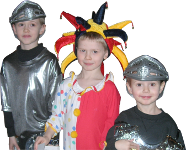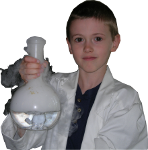Science in Early Childhood
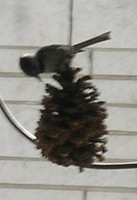
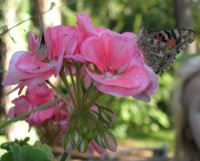 For young children, science should be all about exploration and discovery. Most science topics are in your own backyard. Squirrels, cats, birds, and other animals will sometimes come right up to your window. Put a bird feeder in front of your window and begin identifying different birds. A raccoon came up to our glass sliding door one winter, and my young children were amazed. I described the raccoon as we watched him, to draw attention to details about the animal. After the raccoon left, we looked at its sprawled footprints in the snow. Even a deer came to our city yard, munched on our ivy, and left hoof prints behind. Squirrels are easy to watch, especially when the birds have been messy and dropped bird seed all over the deck. A young child can safely sit just inches away from the munching, furry squirrel, safely protected by the glass sliding door.
For young children, science should be all about exploration and discovery. Most science topics are in your own backyard. Squirrels, cats, birds, and other animals will sometimes come right up to your window. Put a bird feeder in front of your window and begin identifying different birds. A raccoon came up to our glass sliding door one winter, and my young children were amazed. I described the raccoon as we watched him, to draw attention to details about the animal. After the raccoon left, we looked at its sprawled footprints in the snow. Even a deer came to our city yard, munched on our ivy, and left hoof prints behind. Squirrels are easy to watch, especially when the birds have been messy and dropped bird seed all over the deck. A young child can safely sit just inches away from the munching, furry squirrel, safely protected by the glass sliding door.
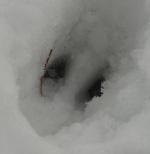 Other animals are smaller and can be viewed with a magnifying glass. Lift a rock and observe insects underneath. Observe ants to analyze their behavior. If an ant hill is stepped on (not by your toddler!), the child can notice how fast the ants work to remove the eggs to safety. Give your child a net to catch butterflies. Better yet, get a caterpillar and watch it turn into a butterfly. You can buy a kit for around $20 at a learning supply store, and live caterpillars are mailed to you with their own food included. A kit for a tadpole to turn into a frog is also available. Your young child will think it is magic, how the metamorphosis takes place. Do this in the spring, or it will take 10 months for the silly tadpole to turn into a frog. (My children enjoyed it anyway, but it was an exercise in patience!)
Other animals are smaller and can be viewed with a magnifying glass. Lift a rock and observe insects underneath. Observe ants to analyze their behavior. If an ant hill is stepped on (not by your toddler!), the child can notice how fast the ants work to remove the eggs to safety. Give your child a net to catch butterflies. Better yet, get a caterpillar and watch it turn into a butterfly. You can buy a kit for around $20 at a learning supply store, and live caterpillars are mailed to you with their own food included. A kit for a tadpole to turn into a frog is also available. Your young child will think it is magic, how the metamorphosis takes place. Do this in the spring, or it will take 10 months for the silly tadpole to turn into a frog. (My children enjoyed it anyway, but it was an exercise in patience!)
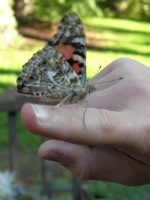 Clear plastic jars provide habitats for any insects or worms you may find. A terrarium provides a longer residence for insects if you provide drops of water and plants that the insect eats. You can go to the library and find a picture book about the one insect you caught, and learn more about it. Your child can learn a lot just by looking at the large pictures of the insect.
Clear plastic jars provide habitats for any insects or worms you may find. A terrarium provides a longer residence for insects if you provide drops of water and plants that the insect eats. You can go to the library and find a picture book about the one insect you caught, and learn more about it. Your child can learn a lot just by looking at the large pictures of the insect.
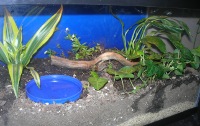 Terrariums can also introduce your children to plant life. We bought a Venus flytrap, a pitcher plant, and a sundew plant. Then we caught flying insects and threw them in to see what would happen.
Terrariums can also introduce your children to plant life. We bought a Venus flytrap, a pitcher plant, and a sundew plant. Then we caught flying insects and threw them in to see what would happen.
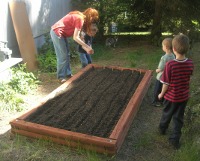 Growing a vegetable garden is ideal for learning about how plants grow, and it causes your child to eat more vegetables. Pulling weeds shows the child the roots, stem, and leaves of a plant. You can walk around your yard identifying flowers and smelling them. You can identify trees in your yard or at a park and do leaf rubbings or rubbings of the tree trunk. If you see some maple seeds lying on the ground, toss them up in the air and show your child how the seeds twirl like helicopters. Look at other seeds. Eat fruit and spit out the seeds, dry them, and start a collection. Or plant them the next spring.
Growing a vegetable garden is ideal for learning about how plants grow, and it causes your child to eat more vegetables. Pulling weeds shows the child the roots, stem, and leaves of a plant. You can walk around your yard identifying flowers and smelling them. You can identify trees in your yard or at a park and do leaf rubbings or rubbings of the tree trunk. If you see some maple seeds lying on the ground, toss them up in the air and show your child how the seeds twirl like helicopters. Look at other seeds. Eat fruit and spit out the seeds, dry them, and start a collection. Or plant them the next spring.
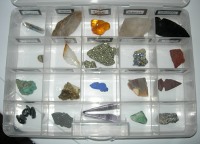 Identify rocks and start a rock collection. Or identify seashells. I got over 100 seashells at a yard sale for fifty cents, and we sorted them in a plastic container from a sporting goods store. We have collected bird nests in the fall, when the birds have flown south for the winter. We also have a collection of fossils and other objects from nature. You can have a science center in your own home, and it can grow over the years.
Identify rocks and start a rock collection. Or identify seashells. I got over 100 seashells at a yard sale for fifty cents, and we sorted them in a plastic container from a sporting goods store. We have collected bird nests in the fall, when the birds have flown south for the winter. We also have a collection of fossils and other objects from nature. You can have a science center in your own home, and it can grow over the years.
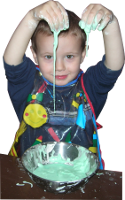 Experiments can be fun for young children, but I have found that the energy expended by the parent does not equal the learning of the child. For the tired parent of toddlers, open-ended activities are more useful. Playing with magnets under supervision is easier than taking out 7 ingredients and doing an experiment that doesn't work. Even if it does work, a young child will not fully understand why. So it's more useful to do these kinds of activities when they are older. Of course, there are a few exceptions. For example, mix 1 cup of cornstarch with a little bit of water (adding a little bit at a time, up to half a cup) and drip green food coloring into it. The substance is a solid and a liquid at the same time. It's fun to play with, even though it's messy.
Experiments can be fun for young children, but I have found that the energy expended by the parent does not equal the learning of the child. For the tired parent of toddlers, open-ended activities are more useful. Playing with magnets under supervision is easier than taking out 7 ingredients and doing an experiment that doesn't work. Even if it does work, a young child will not fully understand why. So it's more useful to do these kinds of activities when they are older. Of course, there are a few exceptions. For example, mix 1 cup of cornstarch with a little bit of water (adding a little bit at a time, up to half a cup) and drip green food coloring into it. The substance is a solid and a liquid at the same time. It's fun to play with, even though it's messy.
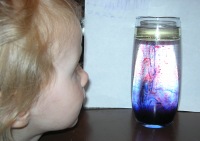 If learning science is a delight in the early years, your child will be light years ahead, and he will begin thinking in a scientific way: paying attention to details and the why behind each phenomenon. Be on the lookout for opportunities to expand the science knowledge of your child. One night my husband took his telescope outside and saw the rings on Saturn. He scooped up each child in his pajamas and held him where he could see through the telescope. They have never forgotten that experience to this day. They want to explore the universe.
If learning science is a delight in the early years, your child will be light years ahead, and he will begin thinking in a scientific way: paying attention to details and the why behind each phenomenon. Be on the lookout for opportunities to expand the science knowledge of your child. One night my husband took his telescope outside and saw the rings on Saturn. He scooped up each child in his pajamas and held him where he could see through the telescope. They have never forgotten that experience to this day. They want to explore the universe.
For more information about Early Childhood Education, click here.








